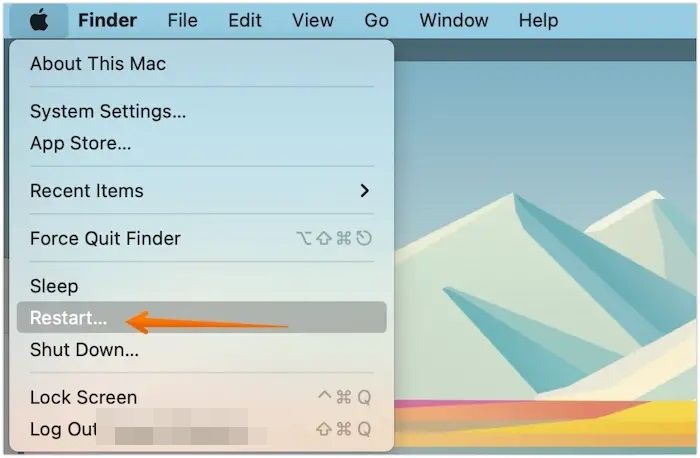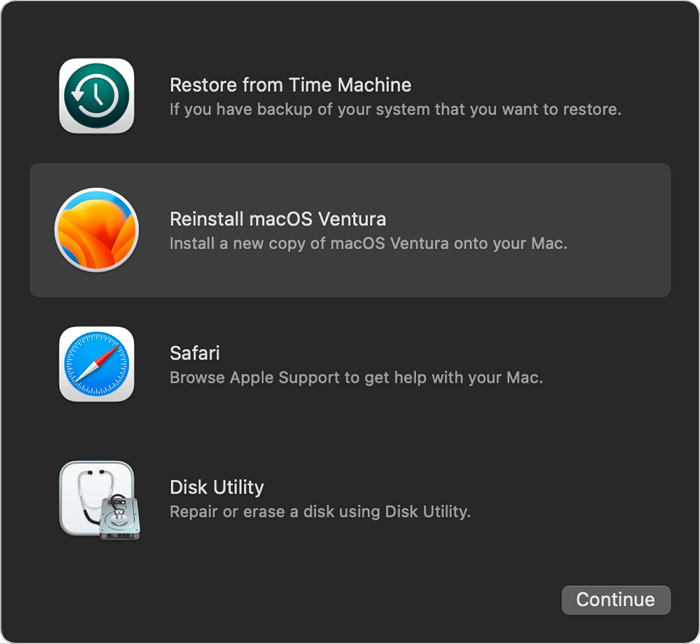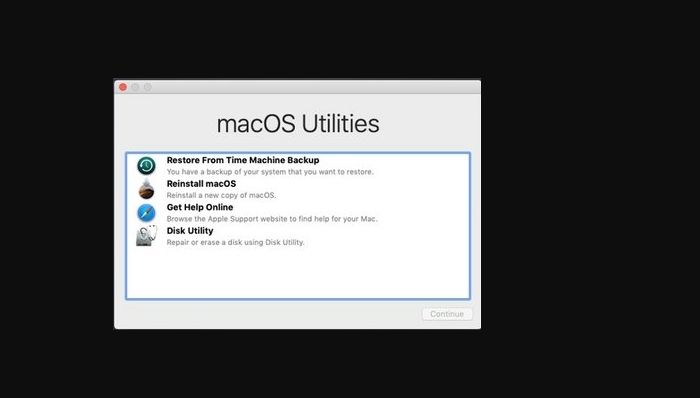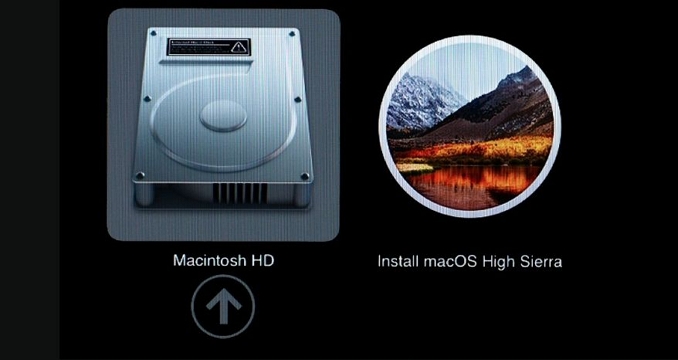Here is the quick navigation to start Mac in recovery mode.
| Workable Solutions | Step-by-step Troubleshooting |
|---|---|
| Fix 1. Enter on Intel-based Mac | Go to the Apple logo. Choose Restart from the drop-down menu. Wait for the system...Full steps |
| Fix 2. Enter on Apple M1 chips | To enter Recovery Mode on Macs with Apple M1 chips, here are the steps you need to follow...Full steps |
| Fix 3. Internet Recovery Mode | Internet Recovery is an excellent option for failing to access the recovery partition...Full steps |
Do you know what Recovery Mode is? The Mac Recovery Mode is precisely as it sounds. In this mode, you get access to the in-built recovery tools of the macOS. You get four main options here – Get help online, reinstall macOS, disk utility, and restore from Time Machine Backup.
When you start Mac into Recovery Mode, the recovery tools get loaded from a specially designated disk partition. It contains a recovery picture along with the macOS installer copy. In most cases, macOS users opt for Recovery Mode to assess and resolve disk problems.
Are you not sure when to start Mac in Recovery Mode? Take a look at these situations listed here –
- Troubleshooting: If you face any issues with your system, using the Recovery mode and the different options is a good idea.
- Restore system: Do you want to restore data from Time Machine backup? Recovery mode allows you to do that with ease.
- Sell the system: It is vital to remember that you must get rid of all data from your device before handing it over. Use the Recovery mode to ensure the system is clean.
- Hard drive issues: Using Recovery Mode can aid in resolving hard drive problems. In that case, you can use boot Mac into Disk Utility.
How to Start Mac in Recovery Mode
Do you want to know how to start Mac in Recovery Mode? The steps are easy; all you have to do is follow them. However, remember that the steps might slightly differ for different models.
Fix 1. Enter Recovery Mode on Mac [Intel-based Macs]
To enter Recovery Mode on Intel-based Macs, here are the steps you need to follow –
Step 1. Go to the Apple logo. Choose Restart from the drop-down menu. Wait for the system to shut down.

Step 2. Press and hold Command and R keys till you come across the Apple logo. Release the keys. The macOS Utilities window will appear.
Fix 2. Enter Recovery Mode on Mac [Apple M1 chips]
To enter Recovery Mode on Macs with Apple M1 chips, here are the steps you need to follow –
Step 1. Turn off the system. Press the power button and hold it. Release it when you see Loading startup options.

Step 2. Select Options from the new screen. Click on Continue. If prompted, enter the admin password.
Fix 3. Enter Internet Recovery Mode
Internet Recovery is an excellent option for failing to access the recovery partition. It is also useful when there are hard drive issues and you can't leverage the recovery mode. If you are having trouble with the existing macOS, the internet recovery mode will download a clean OS version from the internet. However, you need to have stable internet and charge the device.
When your system can't enter the Recovery Mode, it automatically switches to Internet Recovery mode. However, you can also do so manually.
Here are the steps –
Step 1. Turn on the system. Press and hold the Command, Option, and R keys simultaneously.
Step 2. If you see the lock icon, enter the password.

Step 3. Wait for the Wi-Fi menu to come on the screen. Check the list of Wi-Fi networks and choose the one you want. Type the password of the network you are connected to.

Step 4. Now, Mac will download the recovery system image, offering access to different recovery tools. After some time, you will come across the macOS Utilities window.

- Notice:
- These steps are meant explicitly for Intel-based Macs. It may differ from other models.
How to Fix Mac Recovery Mode Not Working
If your Mac recovery is not working or you cannot access it, that is a cause for concern. In that case, you can take a look at the solutions listed below -
- Fix 1. Determine your Mac's model and check how you access it
- Fix 2. Verify your Wi-Fi or Internet connection
- Fix 3. Examine and adjust your peripheral devices
- Fix 4. Install macOS from a USB
Fix 1. Determine your Mac's model and check how you access it
The simplest solution to the Mac recovery mode not working is to check the model you have. Make sure that you use the correct keyboard combinations. For instance, if you have an Intel-based Mac, you need to use Command and R keys at the same time. However, if that doesn't work, you can always opt for Internet Recovery mode.
If you have M1 Macs, there's an alternative option as well. It's known as the Fallback Recovery Mode. With this, you can access the second copy of the operating system.
Fix 2. Verify your Wi-Fi or Internet connection
Another simple thing that's often overlooked is your internet connection. Even if you use Wi-Fi, ensure it's stable and fast. If the internet is still giving trouble, switch to another internet provider.

Fix 3. Examine and adjust your peripheral devices
Have you checked the peripheral devices you use? For instance, you must check your keyboard and ensure the keys are working. If that doesn't still resolve the issue, try using another keyboard.
Fix 4. Install macOS from a USB
Lastly, you can try installing macOS from a USB. Check out the steps you must follow –
Step 1. Turn off the system. Attach the bootable USB. Press and hold the Option/Alt key along with the power button.
Step 2. The above steps will lead you to the Recovery mode.

Step 3. When Startup Manager comes on the screen, select USB-connected external disc. Choose Install macOS. Go ahead with Continue.
After some time, the Mac will reboot by itself.
Bonus Tip: How to Recover Data When Mac Recovery Mode Not Working
Did you face some issues while using the Mac Recovery Mode? Have you experienced data loss and macOS Recovery Mode missing? In that case, the best option is to install the EaseUS Data Recovery Wizard for Mac. It is a professional and reliable data recovery program.
Irrespective of the type of data you have lost, there is nothing to work. EaseUS Data Recovery Wizard for Mac can save you! It aids in the restoration of music files, emails, photos, documents, videos, etc. That way, restoration becomes easy and hassle-free.
EaseUS Data Recovery Wizard for Mac
- You can also use the advanced filter to find deleted files quickly.
- Recover emptied Trash Mac, hard drive, memory card, flash drive, digital camera, and camcorders
- Recover deleted files on Mac from sudden deletion, formatting, hard drive corruption, virus attack, system crash under different situations
How to use EaseUS Data Recovery Wizard for Mac? Follow the steps listed below -
Step 1. Select the drive to be scanned
In the main EaseUS Data Recovery Wizard window, there will be a list of the drives connected to your Mac. Select the drive you need to recover lost/deleted files from, and click the "Search for lost files" button.

Step 2. Select your lost data/files
EaseUS Data Recovery Wizard for Mac will immediately scan your selected disk volume and display the scanning results on the left pane. You can sort the results to find the wanted files if you are looking for certain files.

Step 3. Recover lost/deleted data
Once you have found the desired files, preview the files and then click "Recover" to begin the recovery of your deleted/lost Mac files.

Summary
Mac Recovery Mode is a crucial part of the Apple ecosystem. Different models have various steps to enter the Recovery mode. If issues arise, you can implement different solutions. You can use another keyboard or install macOS via USB.
In the event of data loss, you must opt for the assistance of a specialized data recovery tool. You can use EaseUS Data Recovery Wizard for Mac. The software is reliable, user-friendly, and doesn't need too much technical expertise.
Haven't you tried EaseUS Data Recovery Wizard for Mac yet? Install this software today!
How to Start Mac in Recovery Mode FAQs
Starting Mac in Recovery Mode is easy. To gain more knowledge, take a look at the questions and answers listed below -
1. Why won't my Mac go into recovery mode?
There are various reasons for your Mac not going into recovery mode. These include a faulty keyboard, incorrect keys combination, damaged recovery partition, etc.
2. How to Fix Mac Recovery Mode not working?
To fix Mac Recovery Mode not working, there are multiple solutions one can adopt.
- Firstly, you need to use a different keyboard and check if the correct key combinations are used.
- You can also reset the SMC and try booting Mac into safe mode.
3. What can I do in Mac Recovery Mode?
In the Mac Recovery Mode, you can perform different functions. These include reinstalling macOS, setting security options, repairing internal storage devices, and restoring files from the Time Machine backup.
4. What can I do via Internet Recovery Mode Mac?
You can install a new macOS version with the Internet Recovery Mode Mac. You can also use this mode to troubleshoot issues your system is facing.
Was This Page Helpful?
Cedric Grantham is a senior editor and data recovery specialist of EaseUS. He mainly writes articles and how-to tips about data recovery on PC and Mac. He has handled 10,000+ data recovery cases and is good at data recovery of NTFS, FAT (FAT32 and ExFAT) file systems, and RAID structure reorganization.
Jaden is one of the editors of EaseUS, who focuses on topics concerning PCs and Mac data recovery. Jaden is committed to enhancing professional IT knowledge and writing abilities. She is always keen on new and intelligent products.
Related Articles
-
How to Transfer Stardew Valley Saves Between Different Devices
![author icon]() Rel/2025-07-07
Rel/2025-07-07 -
How to Get BitLocker Recovery Key with Key ID [Full Guide]
![author icon]() Finley/2025-07-04
Finley/2025-07-04 -
Steam Deck Save File Location(All You Should Know)
![author icon]() Larissa/2025-07-04
Larissa/2025-07-04 -
Can't Install macOS Sonoma? Fixed in 10 Proven Ways (2025)
![author icon]() Jaden/2025-09-17
Jaden/2025-09-17
EaseUS Data Recovery Services
EaseUS data recovery experts have uneaqualed expertise to repair disks/systems and salvage data from all devices like RAID, HDD, SSD, USB, etc.